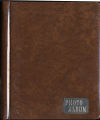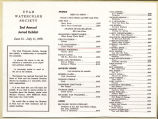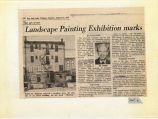| OCR Text |
Show JO E The Salt Lake Tribune, Sunday, June 20, 1976 The art scene Watercolorists open '76 show By George Dibble ; When Rose Ann Peterson finished a summer session class in watercolor three years ago she wondered why Utah artists had not organized a watercolor society. Inquiries .among leading artists brought -Response's that ranged from ^'Who needs a watercolor society ?" to "If s probably a good ^idea but it is too big an -undertaking.'' That was the comment that turned her on. Sturcture And Goals She found that previous attempts to organize a society had failed and with the help of Marilyn Barker and others who were enlisted in the cause, Mr. Dibble she obtained information from similar organizations in other parts of the country, than set up a series of meetings with artists who agreed to act as advisers. Provided with a formal organizational structure and goals, the society was launched and invitations issued to prospective members. The initial annual exhibition was held at Weber College. Making phone calls, writing letters and holding meetings constituted only the beginning procedures for a successful organization. Fundamental policies needed to be established to insure a plan for more than a mutual admiration society or a tea pouring society. Vitally necessary were standardized procedures to develop self-criticism among members and to constantly upgrade the quality of exhibitions. Workshops directed by leading artists were provided. Member works were evaluated in critique sessions. The Second Annual Exhibition opened last week at the University of Utah Museum of Fine Arts answers at least one of the questions asked in the initial drive to form a watercolor society. "What is special about the medium that justifies a separate organization from other types of painting?" There are special characteristics that deserve special attention not alone for historical significance, but because it is a challenging and intensely rewarding means of expression. ; Primitive artists mixed pigments with water, casein (milk) and other vehicles for paintings that have been preserved on canyon walls and caves. Lime water was extensively employed by Renaissance artists for frescoes laid on wet plaster. A similar mixture served as a fluent designing medium for cartoons or preliminary drawings for murals that were to be executed in oil. Artistic Notes Subsequently European artists found the water-color medium useful for field work because of its convenience. English travelers and vacationers on the continent and in the colonies recorded their artistic notes and Turner, Constable and others in the early 29th century established reputations in a serious idiom. French artists likewise found a ready resource for highly personal expressions and Americans John Singer Sargent, Winslow Homer and John Marin among others joined the ranks of distinghished performers in the wed medium. For largely indefensible reasons, museums have generally rated Watercolor painting below oil as a serious medum. Claims that colors are not as permanent as oil, are specious in light of some researches. One American manufacturer has tested the company products in Florida sunshine for more than 100 years with positive results/Unless originally rated as fugitive colors, the water based product has maintained equal fidelity with oil pigments. Prestigious performances by Persian, Indian, Chinese, Japanese and Other Oriental artists have established classical definitions seldom if ever equalled. â- ' Watercolor painting was commonly listed in college programs for female teachers in Eastern schools in 1800 and a fairly casual acceptance of such practices may have eventually dimmed its escutcheon in comparison with oil. Nonetheless, little serious objection can be raised against a high potential for spontaneity and directness. The need for superior control and technical understanding rescues the art from any such roles as a social amenity. Top Award The Utah Watercolor Society established jurying procedures at the outset. The Second Annual was selected from current entries by Professor Maynard Dixon Stewart of the San Jose State College art staff. The group of 40 paintings is of fairly even quality, looking toward firm technical performance in management of the transparent medium. The top award went to studies by Ann Day that show impeccable concern for the logic of color with lucid painting passages â€"â- a distinction which can exert a salutary force for serious handling and control. Other directions will undoubtedly be highlighted in future displays. Within the parameters of this highly sensitive medium will be found provoking innovations that exert challenge in a highly prolific field of endeavor. There are obviously many valid reasons for formation of water color society which are being ably explored by officers, members and advisors of the Utah Watercolor Society. Awards of excellence were given to Sharlene Christiansen for a competent rendering of a lowland march; Ken Davidson's abstract treatment in "Echoes";,£auX.EmBffsnP'iL1nng horizontal appraisal of a trainltation and Norma Forsberg's "Wintry Morn" that comprehends without excess commentary the effulgence of fresh snow. Nancy Lund senses homey warmth in a sympathetic setting, and Rose Ann Peterson scores with an economical account of fall shapes and colors that appear by suggestion as well as overt statement in "Spring at Whites." A Bicentennial Art Exhibition sponsored by Associated Utah Artists and The Salt Lake Tribune is perhaps the largest display of Utah painting exhibited to date. The collection of oils, watercolors, pastels, prints and collages by state artists numbering well over 500 lines the walls of the second floor of the Salt Palace where it will be displayed through. Aug. 15. |

























